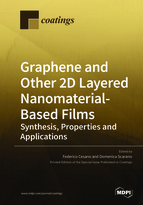Graphene and Other 2D Layered Nanomaterial-Based Films: Synthesis, Properties and Applications
A special issue of Coatings (ISSN 2079-6412).
Deadline for manuscript submissions: closed (31 December 2017) | Viewed by 77279
Special Issue Editors
Interests: composite/hybrid materials and nanomaterials; surface Science; microscopies and spectroscopies; catalysis and photocatalysis
Special Issues, Collections and Topics in MDPI journals
Interests: 2D materials; carbons; oxides; polymers and their composite/hybrid materials and nanomaterials; piezoelectric and piezoresistive materials; functional materials; magnetic materials; interface and surface properties; microscopies and spectroscopies; electrical properties
Special Issues, Collections and Topics in MDPI journals
Special Issue Information
Dear Colleagues,
The Special Issue is dedicated to highlighting relevant advances in the field of coatings based on two-dimensional layered nanomaterials. Graphene and a variety of new 2D inorganic nanosystems, called "graphene-analogues" due to their layered structure (i.e., transition metal dichalcogenides such as MoS2, transition metal oxide, g-C3N4, BN, layered titanates), have all attracted tremendous interest due to their unprecedented properties/superior performance and they can find applications in many fields, from electronics to biotechnology. As far as the field of coatings is concerned, the new layered nanostructures may offer unique and multifunctional properties, including gas-barrier; lubricant; conductive; magnetic; photoactive; self-cleaning; and/or antimicrobial surfaces. This Special Issue aims to publish findings on the synthesis, and to unravel the properties and perspectives of multifunctional films that are at the forefront of science and coating technologies.
It is of great importance to share current knowledge and all progress in these subjects to stimulate new ideas.
In particular, the topics of interest include, but are not limited to, the preparation, properties and applications of coatings and nanocomposite films containing:
-
graphene,
-
graphene-like systems (few-layer graphene, graphene oxide),
-
graphene-analogues (transition metal dichalcogenides, such as MoS2, and WS2),
-
other inorganic 2D structures (layered titanates).
Prof. Dr. Federico Cesano
Prof. Dr. Domenica Scarano
Guest Editors
Manuscript Submission Information
Manuscripts should be submitted online at www.mdpi.com by registering and logging in to this website. Once you are registered, click here to go to the submission form. Manuscripts can be submitted until the deadline. All submissions that pass pre-check are peer-reviewed. Accepted papers will be published continuously in the journal (as soon as accepted) and will be listed together on the special issue website. Research articles, review articles as well as short communications are invited. For planned papers, a title and short abstract (about 100 words) can be sent to the Editorial Office for announcement on this website.
Submitted manuscripts should not have been published previously, nor be under consideration for publication elsewhere (except conference proceedings papers). All manuscripts are thoroughly refereed through a single-blind peer-review process. A guide for authors and other relevant information for submission of manuscripts is available on the Instructions for Authors page. Coatings is an international peer-reviewed open access monthly journal published by MDPI.
Please visit the Instructions for Authors page before submitting a manuscript. The Article Processing Charge (APC) for publication in this open access journal is 2600 CHF (Swiss Francs). Submitted papers should be well formatted and use good English. Authors may use MDPI's English editing service prior to publication or during author revisions.







